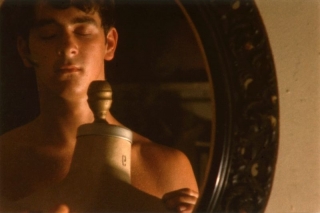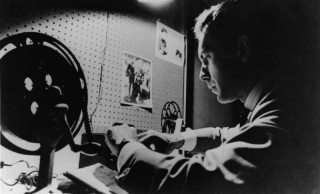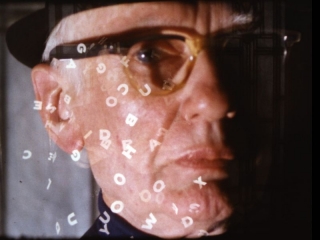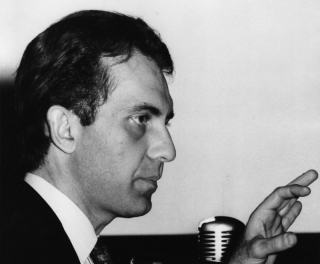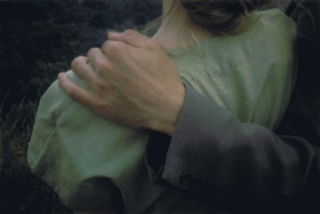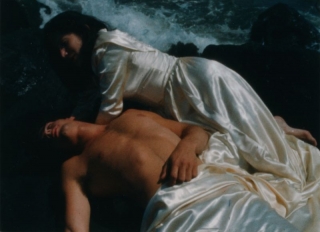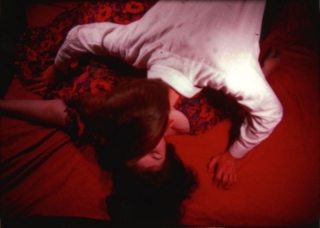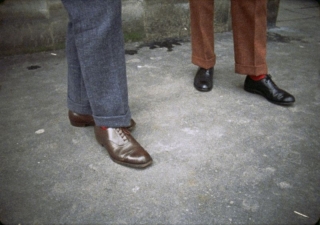Date: 22 November 2014 | Season: Gregory Markopoulos: Film as Film | Tags: Gregory Markopoulos
SORROWS / THE MYSTERIES
Saturday 22 November 2014, at 6:45pm
Vienna Austrian Filmmuseum
In the presence of Robert Beavers
Gregory J. Markopoulos, Sorrows, 1969, 6 min
Gregory J. Markopoulos, The Mysteries, 1968, 64 min
Gregory J. Markopoulos in Europa. Einmal der pulsende Porträt-Kubismus eines Ortes (Richard Wagners Villa in Tribschen). Dann ein narratives Mystery-Passion-Play (im byzantinischen Schwarz-Gold der Villa Stuck und an den statuenbestandenen Gestaden der Isar). In Sorrows formen Längen, Kürzen und Kürzest-Kürzen von black leader und aufzuckende single frames einen Veitstanz einander durchdringender, auseinander-hagelnder und ineinander-stürzender Bilder: Geburt einer Zeit-Orchestrierung, Zeit-Choreographie, Zeit-Musik aus Nicht-Bildern und Bildern. Film: Zeit-Gedicht für die Majestät des Auges. The Mysteries erforscht (wie Swain) das Rätsel der im Augenblick verschlossenen Fülle. Man sieht einen Menschen, ein Ding – und sieht, vielmehr ahnt darin die Welt und alles, was man in ihr und in sich je gesehen hat. Gregory J. Markopoulos: Form-Verwandler, Zeit-Kreator. One particle of time contains trillions of imprisoned images. (Harry Tomicek)
Date: 23 November 2014 | Season: Gregory Markopoulos: Film as Film | Tags: Gregory Markopoulos
EROS, O BASILEUS / HIMSELF AS HERSELF
Sunday 23 November 2014, at 8:30pm
Vienna Austrian Filmmuseum
In the presence of Robert Beavers
Gregory J. Markopoulos, Eros o Basileus, 1966, 49 min
Gregory J. Markopoulos, Himself as Herself, 1967, 60 min
Oh, Eros, ohnmächtig-machtvoller König von body and soul. Eros des Blicks, der ein Porträt in ein Poem und einen „Spielfilm” in ein Labyrinth zu verwandeln weiß. Zwei Filme, mit denen M. sich noch mehr Feinde macht, als er schon je hatte. Die hingegossenen plastischen Jünglinge, das Caravaggio-Chiaroscuro, die am Manierismus geschulte Verprächtigung von Pose und Bild und die Dominanz der dem Zeitgeist spottenden bellezza eines Films hat nicht wenige in den Sixties den Kopf schütteln lassen. Und sie blind gemacht für das, was M. an radikaler filmischer Sprache erschaffen und ausgelotet hat. Das „Auge” einer Einstellung durch fade-outsgleichsam bebend zu schließen und wieder zu öffnen. Einen Mann und eine von ihm separierte Frau durch rasende Montage erst in ein sich umarmendes Paar, dann in eine zwischen den Geschlechtern hin und her fegende, konvulsivische Person zu verzaubern. Im Film durch Film. (Harry Tomicek)
Date: 24 November 2014 | Season: Gregory Markopoulos: Film as Film | Tags: Gregory Markopoulos
EARLY WORK
Monday 24 November 2014, at 6pm
Vienna Austrian Filmmuseum
In the presence of Robert Beavers
Gregory J. Markopoulos, A Christmas Carol, 1940, 5 min
Gregory J. Markopoulos, Christmas USA, 1949, 13 min
Gregory J. Markopoulos, The Dead Ones, 1949, 29 min
Gregory J. Markopoulos, Flowers of Asphalt, 1949-51, 7 min
Gregory J. Markopoulos & Robert C. Freeman, Swain, 1950, 20 min
Seinen ersten Film A Christmas Carol dreht er im Alter von zwölf. Mit The Dead Onesund Flowers of Asphalt begibt er sich auf die Spuren Cocteaus. Er liebt Stroheim, studiert bei Sternberg und schreibt, Jahre später, eine huldigende Botschaft an D.W. Griffith, seinen Wahlverwandten. Er glaubt jedoch, dass im Tonfilm der Ton das Bild zu ersticken droht und der Ton selbst nur der naturalistische Schatten des Bildes ist. Sein Traum von der Errettung des Bildes und Befreiung des Tons im Film lässt ihn ein Film-Universum aus Einzelbildern und Tonauslöschungen entwerfen. „Meine Liebe zum Film ist stärker als jede Moral.” Er ist ein Einsamer und einer der Wenigen. Er ist einer der free radicals des Films. (Harry Tomicek)
Date: 24 November 2014 | Season: Gregory Markopoulos: Film as Film | Tags: Gregory Markopoulos
PORTRAITS
Monday 24 November 2014, at 6pm
Vienna Austrian Filmmuseum
In the presence of Robert Beavers
Gregory J. Markopoulos, Political Portraits 1969, 15 min (excerpt)
Gregory J. Markopoulos, Index – Hans Richter, 1969, 23 min
Gregory J. Markopoulos, Moment, 1970, 6 min
Gregory J. Markopoulos, Saine Acteaon, 1971, 9 min
Es gibt in der Filmgeschichte einen eigenen und auf singuläre Art leuchtenden Erdteil von Porträtfilmen. Es sind jene von Gregory J. Markopoulos. Sie wetterleuchten in ihrem durch sich selbst etablierten Dunkel. Sie flackern in Intervallen, und ihr Flickern erzeugt daraus Reime aus Zeit. Sie setzen eine Nacht aus Bildlosigkeit und setzen in ihre Schwärze Bilder wie vereinzelt aufblühende oder in Schwärmen regnende Sternschnuppen. Sie erfinden den Ton-Film neu, weil sie den Filmen den Ton entziehen, um ihn dann abrupt in Form ungeheurer Blitzangriffe aus Musik oder Geräusch einbrechen und schon wieder in Absenz verschwinden zu lassen – wodurch das Stumme der Filme sich dann in die maßlose Macht von Stille und Schweigen verwandelt sieht. (Harry Tomicek)
Date: 29 November 2014 | Season: Gregory Markopoulos: Film as Film | Tags: Gregory Markopoulos
FILM AS FILM: GREGORY J. MARKOPOULOS
Saturday 29 November 2014, at 6pm
Brighton Museum & Art Gallery
The meticulously crafted films made by Gregory Markopoulos encompass mythic themes, portraiture and studies of landscape and architecture. Employing spontaneous in-camera superimposition and complex editing techniques, he sought to unlock the mystery and energy contained within the single frame. This rare opportunity to encounter a true cinematic visionary celebrates the publication of his collected writings and will be introduced by the book’s editor Mark Webber.
Gregory Markopoulos, Ming Green, 1966, 7 min
Gregory Markopoulos, Through a Lens Brightly: Mark Turbyfill, 1967, 14 min
Gregory Markopoulos, Twice a Man, 1963, 46 min
Presented by Cinecity 15th Brighton Film Festival and supported by the University of Sussex Centre for American Studies, in collaboration with the University of Brighton.
PROGRAMME NOTES
FILM AS FILM: GREGORY J. MARKOPOULOS
29 November 2014, at 6pm
Brighton Museum & Art Gallery
MING GREEN
Gregory J. Markopoulos, USA, 1966, 16mm, colour, sound, 7 min
An extraordinary self-portrait conveyed through multiple layered observations of the filmmaker’s sparsely furnished room in Greenwich Village.
THROUGH A LENS BRIGHTLY: MARK TURBYFILL
Gregory J. Markopoulos, USA, 1967, 16mm, colour, sound, 14 min
The life of painter, dancer and poet Mark Turbyfill, seen in his 70th year, is evoked through a unique form of cinematic portraiture that encompasses the person, their environment and personal objects.
TWICE A MAN
Gregory J. Markopoulos, USA, 1963, 16mm, colour, sound, 46 min
Twice A Man is a fragmented re-imagining of the Greek myth of Hippolytus, who was killed after rejecting the advances of his stepmother. Markopoulos’ vision transposes the legend to 1960s New York and has its main character abandon his mother for an elder man. Employing sensuous use of colour, the film radicalised narrative construction with its mosaic of ‘thought images’ that shift tenses and compress time. One of the touchstones of independent filmmaking, Twice A Man was made in the same remarkable milieu as Scorpio Rising and Flaming Creatures by a filmmaker named ‘the American avant-garde cinema’s supreme erotic poet’ by its key critic P. Adams Sitney.
—Mark Webber
Back to top
Date: 9 December 2014 | Season: Gregory Markopoulos: Film as Film | Tags: Gregory Markopoulos
PRÉSENTATION DES ÉCRITS DE GREGORY J. MARKOPOULOS
Tuesday 9 December 2014, at 7pm
Paris The Film Gallery
Bilingual French / English avec Mark Webber et Helga Fanderl
Nous sommes ravis de vous inviter à une lecture des écrits de Gregory Markopoulos à notre boutique. Mark Webber sera sur place pour présenter et lire en anglais les textes de ce cinéaste et personnage clef de l’avant-garde américaine. Les textes seront également présentés en français, et lus par Helga Fanderl. Venez nombreux!!
Film as Film : The Collected Writings of Gregory J. Markopoulos contient quatre-vingt dix articles inédits par le cinéaste grec-américain qui, étant un contemporain de Kenneth Anger, Stan Brakhage et Andy Warhol, était à l’avant-garde d’un mouvement qui a établi une forme véritablement indépendante du cinéma. À commencer par ses premiers écrits sur l’avant-garde américaine et des auteurs tels que Dreyer, Bresson et Mizoguchi, le livre présente également de nombreux essais sur la pratique personnelle de Markopoulos et sur les films de Robert Beavers, qui ont été publiés seulement dans des revues, éditions auto-éditées ou notes de programme. Les textes deviennent de plus en plus métaphysiques et poétique alors que le cinéaste poursuit son idéal de Temenos, un espace d’archivage et de projection situé sur un site dans le Péloponnèse où son travail épique pourrait finalement coexister en harmonie avec le paysage grec.
Gregory Markopoulos (1928-1992) fut l’un des véritables visionnaires de l’avant-garde américaine. À travers ses exquisses stylisées, premiers films oniriques et à travers ses oeuvres de maîtres éblouissantes de la fin des années soixante à soixante-dix, Markopoulos a défini un langage cinématographique unique d’une rigueur formelle, d’une incomparable beauté visuelle et d’un lyrisme envoûtant. Perfectionniste infatigable, Markopoulos conçu un mode unique de l’art du cinéma, avec un minimum de financement et de ressources, souvent en éditant ses négatifs à la main avec seulement une lame de rasoir et perfectionnant des techniques d’édition à huis clos qui ont apporté une densité poétique à ses films. Dans ses premiers films majeurs, la fascination du mythe et du rituel est évidente, et se retrouve dans le travail ultérieur de Markopoulos, qui, éventuellement, le rappele dans sa Grèce ancestrale. La mythopoésie grisante de premiers films clés comme Swain et Twice a Man est également marquée par une exploration audacieuse du désir sexuel et homosexuel qui était, à tous points de vue, en avance sur son temps. (Harvard Cinema Archive)
Mark Webber est un programmateur de film basé à Londres, qui est à l’origine de grandes séances ou tournées organisées par des institutions telles que la Tate Modern, LUX et ICA (Londres), Whitney Museum (New York), le Centre Georges Pompidou (Paris), Kunsthalle de Bâle, Oberhausen Kurzfilmtage, IFFR Rotterdam et de nombreux festivals internationaux, musées et centres d’art. Il était programmateur pour le Festival BFI de Londres 2000-13, et l’éditeur de Two Films by Owen Land.
Helga Fanderl est une artiste allemande qui travaille avec film, basé à Francfort et Paris. Elle a étudié à la Städelschule Francfort et à la Cooper Union à New York. Depuis 1990, son travail a été présenté dans les cinémathèques, les musées et galeries à travers le monde, et est dans les collections permanentes du Museum für Moderne Kunst (Francfort), Auditorium du Louvre et du Centre Pompidou (Paris).
Date: 10 December 2014 | Season: Gregory Markopoulos: Film as Film | Tags: Gregory Markopoulos
GREGORY J. MARKOPOULOS: DU SANG DE LA VOLUPTÉ ET DE LA MORT
Wednesday 10 December 2014, at 7pm
Paris Centre Pompidou
An early masterpiece by one of the most original filmmakers to emerge from the post-war avant-garde. Commencing with Markopoulos’ first 16mm film, Psyche, which took as its source the unfinished novella by Pierre Louÿs, the trilogy is completed by Lysis and Charmides, both inspired by Platonic dialogues. All three films address homosexual themes, expressing sensuality through the symbolic use of colour and composition. This screening celebrates the publication of an anthology of writings by the filmmaker, and will be introduced by the book’s editor Mark Webber.
Gregory Markopoulos, Psyché, 1947-1948, 16mm, colour, sound, 23 min
Gregory Markopoulos, Lysis, 1947-1948, 16mm, colour, sound, 30 min
Gregory Markopoulos, Charmides, 1947-1948, 16mm, colour, sound, 15 min
Date: 6 January 2015 | Season: Gregory Markopoulos: Film as Film | Tags: Gregory Markopoulos
MARKOPOULOS/BEAVERS: FILM AS FILM
Tuesday 6 January 2015, at 7:15pm
Amsterdam EYE Filmmuseum
Gregory Markopoulos’ status as a leading figure of avant-garde cinema was affirmed by Twice a Man. This homoerotic adaptation of the myth of Hippolytus, set in 1960s New York, employs a radical editing style that integrates single-frame ‘though-images’ within its larger narrative. Five years later, Markopoulos and his partner Robert Beavers, left the US for Europe to pursue filmmaking in relative isolation. Beavers established a regular practice of filming in order to explore the potential of the 16mm camera. Early Monthly Segments is the result of this experimentation – an exhilarating process of discovery that also documents the daily lives of both filmmakers. By the 1980s, Markopoulos had begun to regard the Greek landscape as the ideal environment in which his work should be viewed. Daniël Singelenberg’s Temenos is a rare document of one of the annual presentations of ‘film as film’ at a remote site in the Arcadian countryside.
Gregory J. Markopoulos, Twice a Man, 1963, 46 min
Robert Beavers, Early Monthly Segments, 1968-70/2002, 33 min
Daniël Singelenberg, Temenos, 1982, 12 min
Introduced by Mark Webber.
PROGRAMME NOTES
MARKOPOULOS/BEAVERS: FILM AS FILM
Tuesday 6 January 2015, at 7:15pm
Amsterdam EYE Filmmuseum
TWICE A MAN
Gregory J. Markopoulos, USA, 1963, 16mm, colour, sound, 49 min
Twice A Man is a fragmented re-imagining of the Greek myth of Hippolytus, who was killed after rejecting the advances of his stepmother. Markopoulos’ vision transposes the legend to 1960s New York and has its main character abandon his mother for an elder man. Employing sumptuous colour, the film radicalised narrative construction with its mosaic of ‘thought images’ that shift tenses and compress time. One of the touchstones of independent filmmaking, Twice A Man was made in the same remarkable milieu as Scorpio Rising and Flaming Creatures by a filmmaker named ‘the American avant-garde cinema’s supreme erotic poet’ by its key critic P. Adams Sitney.
EARLY MONTHLY SEGMENTS
Robert Beavers, USA, 1968-70/2002, 35mm, colour, silent, 33 min
“Early Monthly Segments, filmed when Beavers was 18 and 19 years old, now forms the opening to his film cycle, My Hand Outstretched to the Winged Distance and Sightless Measure. It is a highly stylized work of self-portraiture, depicting the filmmaker and his companion Gregory J. Markopoulos. The film functions as a diary, capturing aspects of home life with precise attention to detail, documenting the familiar with great love and transforming objects and ordinary personal effects into a highly charged work of homoeroticism.” (Susan Oxtoby, Toronto International Film Festival).
TEMENOS
Daniël Singelenberg, Greece, 1982, 16mm, colour, silent, 12 min
Dutch filmmaker and writer Daniël Singelenberg travelled to Greece for the early Temenos screenings. His personal documentary of the 1982 festival of Film as Film in Arcadia shows the preparation of the screening space and the idyllic landscape that surrounds it, and is one of the very few documents of Markopoulos and this unique event.
Back to top
Date: 6 January 2015 | Season: Gregory Markopoulos: Film as Film | Tags: Gregory Markopoulos
THE ILLIAC PASSION
Tuesday 6 January 2015, at 9:15pm
Amsterdam EYE Filmmuseum
Throughout his life, Markopoulos remained closely connected to his heritage and made many works that connected with ancient Greek culture. The Illiac Passion, one of his most highly acclaimed films, is a visionary interpretation of ‘Prometheus Bound’ starring mythical beings from the 1960s underground. The cast includes Jack Smith, Taylor Mead, Beverly Grant, Gregory Battcock and Gerard Malanga, and Andy Warhol appears as Poseidon riding an exercycle, The extraordinary soundtrack of this re-imagining of the classical realm features a fractured reading of Henry Thoreau’s translation of the Aeschylus text and excerpts from Bartók’s Cantata Profana. Writing about this erotic odyssey, Markopoulos asserted that “the players become but the molecules of the nude protagonist, gyrating and struggling, all in love, bound and unbound, from situation to situation in the vast sea of emotion.”
Gregory J. Markopoulos, The Illiac Passion, 1964-67, USA, 16mm, colour, sound 91 min
“Metamorphosis of the filmmaker. Passions of the filmmaker. Out of his breast the free flowing blood of the creation of a motion picture which depicts the passions of mankind and of everyman in general. The filmmaker selecting and offering to his actors the inheritance of themselves, transforming them through themselves, their own life’s scenario, onto the motion picture screen. A screen in which everything is both transfixed and changed. Not only the filmmaker undergoes changes, i.e. the creative endeavour, but his actors or non-actors, and everyone who associates himself with the very moments during which the filmmaker is working. In this case the greatest alteration taking place towards the film spectator. The new film spectator of the new cinema.” (Gregory J. Markopoulos, 1967)
Introduced by Mark Webber.
Date: 30 January 2015 | Season: Gregory Markopoulos: Film as Film | Tags: Gregory Markopoulos
FILM AS FILM: LAS PELÍCULAS DE GREGORY J. MARKOPOULOS
3—20 February 2015
Spanish touring programme
“There is no language. There is no art. There is no knowledge. There is but film as film: the beginning and the eternal moment.” (The Intuition Space, 1973)
Gregory J. Markopoulos (1928-92) was one of the most original filmmakers to emerge in post-war American cinema. His films, which often translated literary or mythological sources to a contemporary context, are celebrated for their extraordinary creativity, the sensuous use of colour and innovations in cinematic form. A contemporary of Maya Deren, Kenneth Anger and Jonas Mekas, Markopoulos was amongst those at the forefront of a generation that liberated cinema by developing new modes of expression. Having made his first 16mm film (Psyche) in 1947, as a student at USC, he went on to produce several key works of the avant-garde such as Twice a Man (1963) and The Illiac Passion (1964-67).
At the end of the 1960s, he moved to Europe to pursue a very individual path, withdrawing his films from distribution and making them almost impossible to see. Firmly believing that a filmmaker should be responsible for all aspects of his work, he conceived the Temenos, a monographic archive for the presentation, preservation and study of his films. Late in life he chose to re-edit his entire oeuvre into a monumental 80-hour long film to be shown only at a remote location near to his ancestral home in Greece. This speculative project is being realised posthumously by an open-air screening event that has taken place every four years since 2004.
Markopoulos’ films encompass mythic themes, portraiture and studies of landscape and architecture. By employing complex editing techniques and spontaneous in-camera superimposition, he sought to unlock the mystery and energy contained within the single frame. This rare opportunity to experience the work of a true pioneer of independent filmmaking celebrates the publication of Film as Film: The Collected Writings of Gregory J. Markopoulos.
—Mark Webber
Presented in collaboration with Revista Lumière and The Visible Press, with thanks to Robert Beavers and Temenos.
Film as Film 1: Du Sang, de la volupté et de la Mort
Gregory J. Markopoulos, Psyche, 1947, USA, 16mm, colour, sound, 24 min
Gregory J. Markopoulos, Lysis, 1948, USA, 16mm, colour, sound, 25 min
Gregory J. Markopoulos, Charmides, 1948, USA, 16mm, colour, sound, 11min
Tuesday 3 February 2015 at Barcelona Filmoteca de Catalunya – Introduced by Mark Webber
Saturday 7 February 2015 at Madrid La Casa Encendida – Introduced by Mark Webber
Wednesday 18 February 2015 at A Coruña CGAI
Film as Film 2: Gammelion
Gregory J. Markopoulos, Bliss, 1967, Greece, 16mm, colour, sound, 6 min
Gregory J. Markopoulos, Gammelion, 1968, Italy, 16mm, colour, sound, 54 min
Wednesday 4 February 2015 at Barcelona Filmoteca de Catalunya – Introduced by Mark Webber
Sunday 8 February 2015 at Madrid La Casa Encendida – Introduced by Mark Webber
Thursday 19 February 2015 at A Coruña CGAI – Introduced by Mark Webber
Film as Film 3: Portraits
Gregory J. Markopoulos, Through a Lens Brightly: Mark Turbyfill, 1967, USA, 16mm, colour, sound, 14 min
Gregory J. Markopoulos, Political Portraits, 1969, Switzerland, 16mm, colour, silent, 12 min (excerpt)
Gregory J. Markopoulos, The Olympian, 1969, Italy, 16mm, colour, silent, 23 min
Gregory J. Markopoulos, Gilbert and George, 1975, France, 16mm, colour, silent, 12 min
Thursday 5 February 2015 at Barcelona Filmoteca de Catalunya – Introduced by Mark Webber
Monday 9 February 2015 at Madrid Museo Reina Sofia – Introduced by Arnau Vilaró
Friday 20 February 2015 at A Coruña CGAI – Introduced by Mark Webber
Film as Film 4: The Illiac Passion
Gregory J. Markopoulos, The Illiac Passion, 1964-67, USA, 16mm, colour, sound, 91 min
Sunday 8 February 2015 at Barcelona CCCB Xcentric – Introduced by Revista Lumière
Tuesday 10 February 2015 at Madrid Museo Reina Sofia
Friday 20 February 2015 at A Coruña CGAI

